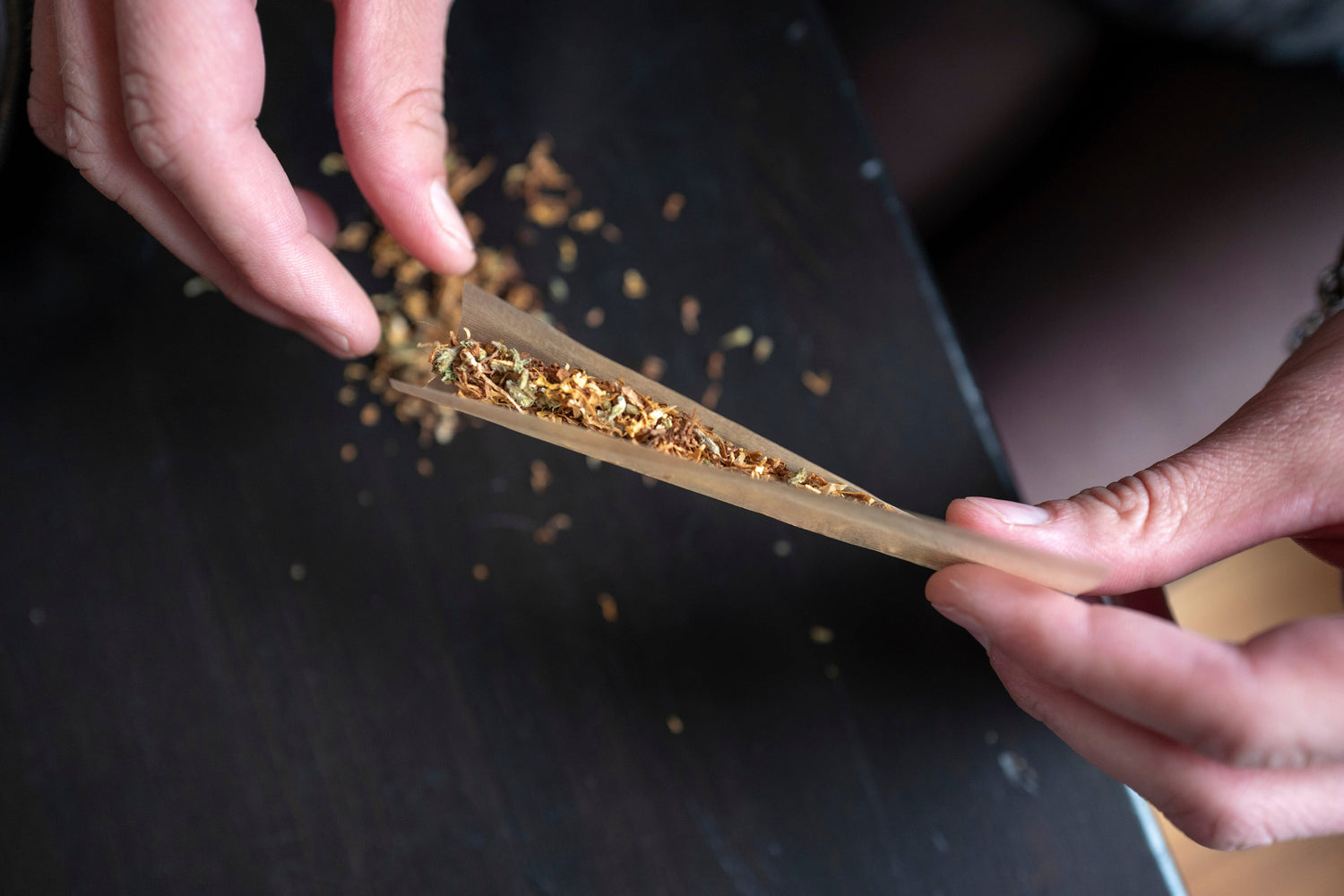Rolling paper thickness directly determines rolling success through its impact on tear resistance, burn rate, and handling difficulty, with an optimal thickness ranging from 12 to 30 GSM, depending on the user's experience.
Incorrect rolling paper thickness causes specific problems: ultra-thin papers (12-15 GSM) tear easily for beginners, while thick papers (25+ GSM) burn faster and produce harsh flavors. For a complete foundation on rolling paper materials and performance factors, consider how thickness interacts with other paper characteristics. Whether you're struggling with delicate ultra-thin papers or finding thick papers too harsh, this guide provides the knowledge you need to match thickness to your rolling skills and preferences.
Understanding Rolling Paper Thickness Measurements
Rolling paper thickness is measured in GSM (grams per square meter), with most papers ranging from 12 to 30 GSM. The market is divided into four categories based on their weight and handling characteristics.
The four main categories are:
- Ultra-thin (12-15 GSM) - Rice or specialized hemp, requiring advanced skills
- Thin (16-20 GSM) - Most popular category, used by 60% of experienced rollers
- Medium (21-30 GSM) - Most forgiving for beginners, 85% tear resistance improvement
- Thick (31+ GSM) - Less common, specialty use only
How Thickness Affects Paper Properties
Thinner rolling papers (12-20 GSM) require 50% gentler handling pressure and precise moisture control, while thicker papers (25-30 GSM) withstand 3x more manipulation force without damage.
Tear resistance increases with thickness, but flexibility decreases. Thinner papers conform better to irregular packing, while thicker papers provide more predictable structural behavior.
Thinner papers are more sensitive to humidity changes, while thicker papers maintain consistency across varied environmental conditions.
Impact of Thickness on Rolling Performance
Paper thickness significantly alters the rolling experience by influencing handling characteristics during construction. Each thickness category offers distinct advantages and challenges that appeal to different skill levels and usage priorities.
Ultra-Thin Papers: Maximum Skill Required
Ultra-thin rolling papers (12-15 GSM) have a 70% higher tear risk and require humidity levels of 60-65% for optimal handling. Success demands advanced technique, a proper workspace setup, and patience in the face of occasional failures.
Benefits: 90% flavor preservation compared to thick papers, 40-60% longer burn times, minimal paper taste interference.
Requirements: Not suitable for rushed rolling or situations where reliability matters more than performance.
Medium Thickness: The Beginner Sweet Spot
Medium-thickness papers (21-25 GSM) provide 80% reduced tear risk with superior structural stability. They allow for mistake correction during rolling without requiring a restart, burn consistently across various environmental conditions, and work reliably with different material types.
Thick Papers: Easy Handling, Compromised Performance
Thick papers (25+ GSM) offer maximum handling ease but burn 30-50% faster than ultra-thin options and introduce 200-300% more paper taste interference.
Thickness Effects on Burn Quality
The relationship between paper thickness and combustion performance creates significant differences in session length, flavor preservation, and overall smoking satisfaction. Understanding these relationships helps optimize material efficiency and session quality.
Burn Rate Control
Thinner papers burn slower counterintuitively: 12-15 GSM papers contain 50% less combustible material per square millimeter than thick papers. Ultra-thin papers create controlled combustion zones with 30% lower peak temperatures, extending session length.
Thick papers contain more combustible material that sustains hotter, faster burns, leading to shorter session times despite appearing more substantial.
Flavor Preservation
Ultra-thin papers (12-15 GSM) contribute less than 5% of total smoke volume, preserving 95% of the herb flavor profile compared to 70-80% preservation with thick papers.
Thicker papers (25+ GSM) introduce significant combustible material that masks herb flavors and creates harsh paper taste interference, particularly noticeable with premium materials.
Material and Thickness Combinations
Different paper materials perform optimally at specific thickness ranges, creating combinations that excel in meeting particular user needs. Understanding these material-thickness relationships helps identify options that deliver both rollability and performance.
Rice Papers: Ultra-Thin Excellence
Rice rolling papers achieve optimal performance at 12-14 GSM, delivering 50-70% longer sessions than wood pulp alternatives. The material's uniform density performs well at low GSM measurements, making rice the preferred choice for flavor preservation and extended burn times.
Requires advanced handling techniques and optimal environmental conditions.
Hemp Papers: Versatile Thickness Range
Hemp papers perform optimally across the 16-25 GSM range, offering 40% better tear resistance than rice papers while maintaining their slow-burning characteristics. Medium-thickness hemp papers provide easier handling than ultra-thin options while preserving good flavor and burn performance. To learn more about hemp-based rolling papers and their unique properties, consider how the material's natural characteristics make it suitable for various thickness applications.
Wood Pulp Papers: Reliable Medium Thickness
Wood pulp papers excel in medium-thickness ranges (21-30 GSM), where their structural characteristics provide a forgiving and consistent rolling experience. Less suitable for ultra-thin applications, but offers good value and wide availability for dependable results.
Health and Safety Considerations
Paper thickness affects potential health implications through additive content and combustion byproducts. Thicker papers often require more processing chemicals and additives that can increase exposure to unwanted substances during use.
Additive Content by Thickness
Ultra-thin papers (12-15 GSM) contain 60-80% fewer additives than thick papers because performance depends on pure material quality rather than chemical burn enhancers or structural strengtheners.
Medium and thick papers often require burn rate modifiers and structural strengtheners that introduce additional chemicals into the smoking experience.
Select papers from manufacturers that clearly list ingredients and use chemical-free processing. Companies like Futurola manufacture papers in France using chemical-free processes at a thickness of 12 g/m².
Storage and Preservation by Thickness
Different GSM ranges require specific storage approaches to maintain optimal performance characteristics and prevent degradation. Environmental sensitivity varies significantly across different thickness categories, necessitating tailored preservation methods.
Ultra-Thin Paper Storage Requirements
Ultra-thin papers (12-15 GSM) require the most controlled storage conditions due to their sensitivity to environmental changes. Store in airtight containers with humidity control packets, maintaining an internal humidity level of 50-55%.
Temperature fluctuations affect ultra-thin papers more severely than thick papers. Avoid storing items near heating vents, windows, or areas with temperature swings exceeding 10°F within 24 hours.
Check ultra-thin papers monthly for brittleness or limpness, which may indicate storage problems. Replace humidity control packets every 3 to 4 months to maintain consistent conditions.
Medium and Thick Paper Storage
Medium papers (21-25 GSM) tolerate more storage variation but benefit from being stored in sealed containers, which prevent dust and contamination. Standard room temperature storage (65-75°F) works well without humidity control.
Thick papers (25+ GSM) require minimal storage precautions beyond keeping them dry and dust-free. Standard packaging often provides adequate protection for 6-12 months.
Storage Longevity by Thickness
Ultra-thin papers maintain peak performance for 8-12 months under optimal storage conditions, 3-6 months in average conditions. Signs of degradation include increased tearing and inconsistent burning.
Medium-thickness papers remain usable for 18-24 months with basic storage, while thick papers can last 2-3 years without significant performance decline.
Rotate older papers to the front of storage to use before they degrade in quality. Mark purchase dates on packages to track storage time and maintain quality standards.
Practical Selection Guide
Your optimal paper thickness depends on specific usage scenarios, experience level, and performance priorities. Different situations call for different thickness strategies to optimize results and minimize frustration during rolling and use.
Beginner Strategy
Start with hemp papers in the 21-25 GSM range. They provide 75% forgiveness for rolling errors while delivering good flavor preservation and consistent burn characteristics.
Progress to thinner papers gradually after 3-6 months of consistent practice. Test slightly thinner options periodically to assess skill development.
Advanced User Optimization
Experienced rollers can utilize ultra-thin papers (12-15 GSM) for optimal flavor preservation and extended burn times. Consider premium processing quality, as performance differences between quality and budget options become more pronounced at extremely thin levels.
Environmental Factors
Outdoor conditions: Use thicker papers (21-30 GSM) that resist wind, humidity, and temperature variations.
Indoor controlled conditions: Enable optimal use of thin papers where environmental factors don't interfere.
Social situations: Medium-thickness papers roll reliably under time pressure and accommodate less experienced participants.
Common Selection Mistakes
Many users choose papers based on incorrect assumptions about thickness performance or select options that don't match their actual needs and skill levels. Avoiding these common errors prevents frustrating experiences and wasted materials.
Assuming thick papers burn longer: Thick papers (25+ GSM) actually burn 30-50% faster than ultra-thin papers due to increased combustible material density.
Choosing ultra-thin papers prematurely: Users with less than 6 months of experience have 60-80% failure rates with papers of 12-15 GSM. Performance advantages only matter if you can roll consistently.
Ignoring environmental factors: Papers that perform well indoors may fail to do so outdoors. Match thickness to your actual usage conditions.
Brand focus over specifications: Even premium brands offer different thickness options to cater to various user types. Check GSM ratings, not just brand reputation.
Troubleshooting Thickness-Related Problems
Even with proper thickness selection, specific issues can arise that require targeted solutions based on your paper's GSM range. Most problems stem from environmental factors or mismatches in technique with paper characteristics.
Ultra-Thin Paper Tearing Issues
When 12-15 GSM papers tear consistently, check workspace humidity first. Increase humidity to 55-65% using a room humidifier or work near a bathroom after showering. Reduce handling time by pre-arranging all materials within arm's reach.
Lower the material's moisture content to 8-10% if the paper tears during sealing. Overly moist material creates wet spots that weaken ultra-thin papers. Use fingertip pressure exclusively. Fingernails puncture thin papers instantly.
Switch to 16-18 GSM papers temporarily if tears persist despite environmental adjustments. Build confidence with slightly thicker options before returning to ultra-thin papers.
Thick Paper Burning Too Fast
When 25+ GSM papers burn rapidly, reduce material density by 20-30%. Thick papers trap heat that accelerates combustion when overpacked. Create looser construction with better airflow.
Check material moisture. Thick papers perform better with 12-15% moisture content compared to 8-10% optimal for thin papers. The additional paper mass requires more moisture to regulate burn speed.
Consider switching to medium-thickness papers (21-24 GSM) that provide easier handling while burning more slowly than thick options. For comprehensive strategies on achieving extended burn times, tips for slow-burning rolling papers can help optimize your technique regardless of thickness choice.
Environmental Problem Solutions
High humidity (70%+) causes thin papers to become limp and thick papers to expand. Store papers in sealed containers with desiccant packets and work in air-conditioned spaces when possible.
Low humidity (30%-) makes all papers brittle, but ultra-thin papers become unusable. Increase workspace humidity or switch to medium-thickness papers during dry seasons.
Wind affects thin papers more severely. Use thick papers (25-30 GSM) for outdoor rolling or find sheltered locations when using thin papers.
Quick Fixes for Common Failures
Paper tears during rolling: Reduce pressure by 50% and slow down movements. Practice with cheaper papers first.
Uneven burning: Check material distribution. Concentrate more toward the center, taper toward ends regardless of paper thickness.
Frequent relighting: Usually indicates overpacking. Reduce material density and ensure proper airflow before lighting.
Testing Your Optimal Thickness
Systematic experimentation helps identify your ideal paper thickness through objective evaluation, rather than relying on guesswork. Develop a testing approach that accounts for rolling skill, preferences, and typical usage scenarios.
Create consistent testing conditions using the same material, rolling environment, and technique across different thickness options. This isolates thickness effects from other variables.
Start with medium-thickness papers (21-25 GSM) and test both thinner and thicker options to establish your comfort range. Evaluate both rolling ease and smoking performance for each thickness.
Document results, noting which thickness works best for different situations and material types.
Choosing Your Ideal Thickness
Match thickness to your rolling frequency and skill level for optimal results. Your choice should strike a balance between handling characteristics and performance priorities, tailored to your specific needs and experience.
Beginners (0-6 months): Start with 21-25 GSM hemp papers for reliable results and skill development.
Intermediate (6+ months): Test 16-20 GSM options as technique improves.
Advanced (1+ years): Consider 12-15 GSM rice papers for optimal flavor and burn performance.
Your optimal thickness balances handling characteristics and performance priorities. Thinner papers offer superior flavor and burn quality but require developed technique. Test systematically rather than jumping to the thinnest options immediately.
Your Path to Perfect Thickness Selection
Choose thickness based on your rolling skill level and typical usage conditions. Beginners should start with high-quality, medium-thickness rolling papers (21-25 GSM) and progress to thinner options after 3-6 months of consistent practice and successful development of their rolling technique.
Thinner papers offer a better flavor and burn characteristics, but require an advanced technique. Thicker papers provide reliability and forgiveness for developing rollers. Test different options systematically to find what works best for your specific needs and preferences. At Futurola, we understand the importance of matching paper thickness to your skill level and provide quality options designed for optimal rolling performance.





LEAVE A COMMENT
All comments are moderated before being published.
This site is protected by hCaptcha and the hCaptcha Privacy Policy and Terms of Service apply.